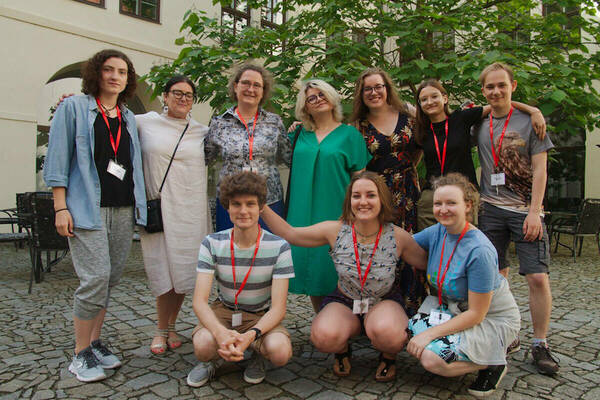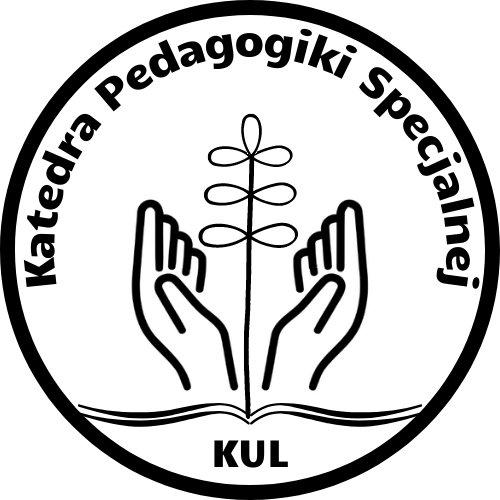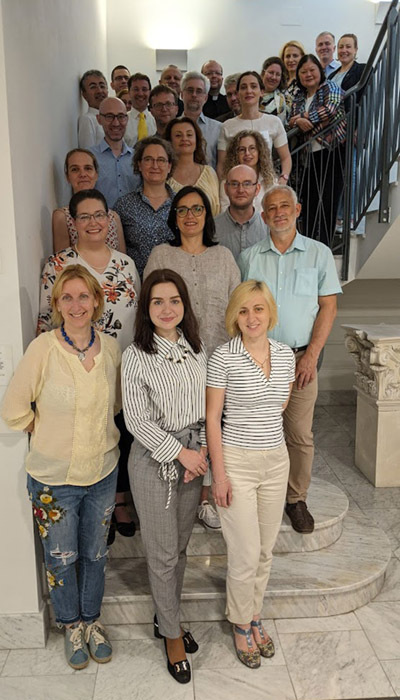
Ewa Domagała-Zyśk is a professor of pedagogy in the Faculty of Social Sciences in the Institute of Pedagogy at John Paul II Catholic University of Lublin, Poland. She specializes in the teaching of English as a foreign language to the deaf and hard of hearing, special education, and the social and emotional competencies of students with disabilities. She has participated in two initiatives of the Catholic Universities Partnership facilitated by the Nanovic Institute for European Studies: the Catholic Leadership Program at the University of Notre Dame in 2019 and the Advanced Leadership Program in Rome in 2022.
The John Paul II Catholic University of Lublin in Poland has quite a condensed campus at Raclawickie Street. The only square to cross is the one between the John Paul II Collegium building and the Academic Church. Though it may take two minutes to cross it, this is a space that makes you think deeply. Every time I am there I feel grateful that I work at an institution where it is possible to visit Our Lord any time you are at this address. It is not like crossing the border between the rational and irrational, or between the sacrum and profanum. My Lord’s address and my (our) work address are the same. This still amazes me.
This proximity to the sacred has influenced many aspects of my work at KUL. One example has been the changes to my job description that I have experienced here and there in recent years. When I started working at KUL (actually, straight after graduating from the university) I was sure about my duties: research and teaching, to the glory of God and serving the country (as the mission statement says: Deo et Patriae). At a later date, and unexpectedly, it became clear that my duties also included leadership: I started to lead international projects, I was appointed a vice dean for the Faculty of Social Sciences (2016-2020), and, finally, I was appointed chair of the Department of Special Education, leading both the team and the whole five-year program.
Educated as a pedagogue, with such limited competencies in human resources, public relations, accountancy, management, and law, I was lucky enough to participate in two programs facilitated by the Nanovic Institute for European Studies as part of the Catholic Universities Partnership: the Catholic Leadership Program at the University of Notre Dame in summer 2019 and the 2022 Advanced Leadership Program in Rome. These experiences provided a boost that helped me to design a framework for my leadership role within university structures. As I reflect today, I see three main pillars within my role as a leader.
The first is having a clear vision and mission for the team you are leading. I must admit that before the 2019 program at Notre Dame, I did not care too much about these elements. Of course, I was aware of the words included in the mission and vision statements of my university — but they seem so removed from everyday teaching and research! The leadership program helped me to see that maintaining a clear vision and mission plays a crucial role in every team.

That is why when I started to lead my present team, the Department of Special Education, we spent many intensive hours, in person and online, discussing our department’s mission and vision. Finally, we came up with a logo for the department, which shows the main elements of our vision. Firstly, we need to base our work on research, not just on practical activities. This is why an open book forms the base of the logo (right). Next, we want to support but not dominate, and this is represented by open hands. Finally, we want to support children and adolescents with disabilities and special needs in an integral way — in every single sphere of their lives, physical, psychological, social, cognitive, and spiritual. In the logo, these five elements are represented in five leaves integrated into a single plant. For our team, I must admit, formulating these short but significant principles was a powerful experience. They are like a lantern, a guide for when we are not sure if we need to be involved in a new activity or endeavor. In these moments, it is enough to have a look at the logo!
Though I visited numerous European universities, the Leadership Program at the Nanovic Institute was my first opportunity to spend two weeks at an American Catholic university. The second important lesson I learned there (both during the classes and while observing university life), and which ultimately formed a second pillar for my leadership, is having a strong commitment to one’s university. This commitment provokes one to work as diligently as possible not only for their personal development but for the development of their university. This is something like a slogan, but the Leadership Program shed new light on it.
Since then, my colleagues and I have had many chances to practice this lesson. It guided us through the first months of 2022 when our city of 400,000 inhabitants became host to more than 500,000 refugees from Ukraine. Everybody from my department was involved in receiving our Ukrainian neighbors. What did we do differently that we might not have done in the past? We were involved in this challenge not as individuals, but as members and leaders of the KUL community. Several dozen students answered our call and on 26 February 2022, we started a volunteer project working with Ukrainian children — especially those with disabilities — in Lublin’s Little Prince House. The project provided educational and therapeutic meetings 5 days a week until June 2022, ending with a theater play and a great celebration of friendship and gratitude.

Gratitude, appreciation, and recognition form the third pillar of my leadership style, which I learned at Notre Dame during this significant summer of 2019. The Nanovic Institute’s Senior Associate Director Monica Caro’s lecture on diverse ways of recognition, her experience (which she kindly shared with us), and the whole atmosphere at the Nanovic Institute strengthened my intuition with professional tools. I must admit that in our Polish culture, gratitude is quite often understood as a weakness. Furthermore, the leader, more often than in other international organizational cultures, is regarded as the only one to whom you should be grateful and there is no expectation that they will express gratitude in return. The organizational culture at Notre Dame is a culture of gratitude — that is what I learned.
Bearing this in mind, the very first activity I started with my new team was to organize, in this uneasy time of the pandemic, a celebration of the 50th anniversary of our colleague’s work at KUL with the publication of an 800-page volume of articles and essays dedicated to the jubilant, Professor Dorota Kornas-Biela. The innovative idea was not only to collect the texts, which is a kind of academic tradition, but to ask authors to prepare a personal dedication to the Jubilant showing their gratitude. Although people were not sure at the beginning, we succeeded. In the end, every single text had an introduction: a letter that remembered some past events, a few sentences of appreciation that had never been spoken or heard before, and even a poem. Many people thanked us for creating a space for these words of recognition to be expressed.
The Nanovic Leadership program completely turned my thinking about university, leadership, and recognition around and I suppose I am quite a good student. Last month, I finished another international program and our leader said at the end: “And now I want to cite our colleague Ewa Domagała-Zysk.” At this point, I started to wonder which fragment of my last paper they would cite, but the leader continued: “because as a sub-leader of one of the tasks she was constantly teaching us a great lesson: that we should often say thank you one to another. So, let’s thank one another for the time we spent together during the whole project.” I must admit, I was not disappointed. Though it was not a fragment of my paper, it was great that even more people were able to learn this lesson.
Thank you, Nanovic, for the inspiration!
Originally published by at crossingthesquare.nd.edu on November 28, 2022.